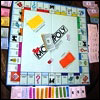Session Overview

|
In the previous lectures, we began to learn about firms’ decisions in a competitive market where there are a large number of firms. However, different markets have different characteristics, and in some markets there may be only one or a few firms. In this lecture, we begin to learn about the operations of a monopoly market, where only one firm is producing a given good. The game Monopoly is named after the economic concept, in which one firm dominates an entire market. Image courtesy of William Boncher on Flickr. |
Keywords: Monopoly; marginal revenue; marginal cost; profit maximization; shutdown rule; market power; price discrimination.
Session Activities
Readings
Before watching the lecture video, read the course textbook for an introduction to the material covered in this session:
Lecture Videos
Resources
Check Yourself
Concept Quiz
This concept quiz covers key vocabulary terms and also tests your intuitive understanding of the material covered in this session. Complete this quiz before moving on to the next session to make sure you understand the concepts required to solve the mathematical and graphical problems that are the basis of this course.
Question 1
What is the key defining feature of a monopoly?
All three definitions are synonymous: monopolies are characterized by the presence of a single firm. This firm is then a price maker, rather than a price taker, and it faces a downward-sloping demand curve.
Question 2
What point defines the optimal quantity produced for a monopolist?
The correct answer is that the optimal quantity produced for a monopolist is defined at the point where the marginal cost is equal to the marginal revenue. It is not the case that the marginal cost is equal to the price. This is accurate in a competitive market, where marginal revenue and price are equivalent, but not in a monopoly. The point of tangency between an isoquant and an isocost curve defines the optimal mix of inputs for a firm given a level of production (i.e., it solves the cost minimization problem), but it does not solve the problem of determining the optimal production level.
Question 3
In general, the mark-up charged by monopolists is higher when which of the following properties holds?
The correct answer is that the mark-up charged by monopolists is higher when demand for the good is highly inelastic. In this case, the monopolist can raise the price of the good considerably without losing many sales (think, for example, of a good such as a pharmaceutical drug for which there are few substitutes). Highly elastic demand for the good and the existence of close substitutes for the good are equivalent concepts. In this case, consumers will switch to another good when the monopolist attempts to raise the price (i.e., they will buy oranges instead of apples). The mark-up does not directly vary with the price level.
Question 4
If monopolists can perfectly price discriminate, what quantity is maximized?
When monopolists can perfectly price discriminate, price and quantity sold are equal to the competitive market level (i.e., they are maximized). However, the entire surplus accrues to producers as producer surplus, while consumers have zero surplus.








